airbag off AUDI A5 COUPE 2010 Owners Manual
[x] Cancel search | Manufacturer: AUDI, Model Year: 2010, Model line: A5 COUPE, Model: AUDI A5 COUPE 2010Pages: 360, PDF Size: 84.39 MB
Page 16 of 360
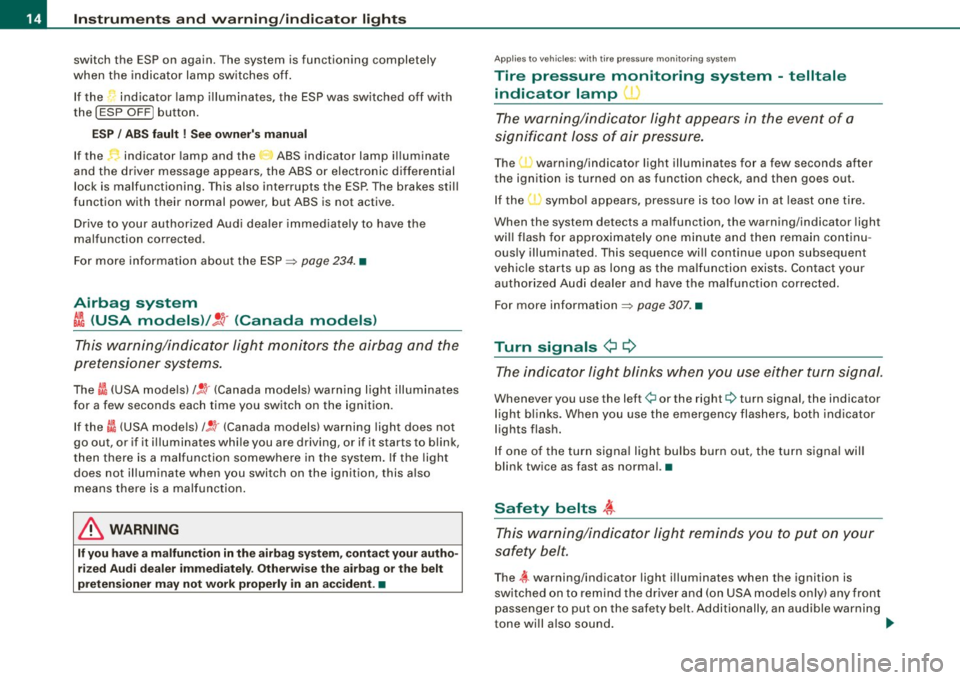
Instruments and warning/indicator lights
switch the ESP on again . The system is functioning completely
when the indicator lamp switches off.
If the indicator lamp illuminates, the ESP was switched off with
the !ESP
O FF J button.
ESP / ABS fault ! See owner's manual
If the indicator lamp and the ABS indicator lamp illuminate
and the driver message appears, the ABS or electronic differential
lock is malfunctioning. This also interrupts the ESP. The brakes still
function with their normal power, but ABS is not active.
Dr ive to your author ized Aud i dealer immediate ly to have the
malfunction corrected.
For more information about the ESP =>
page 234. •
Airbag system
~i (USA models) / !l (Canada models)
This warning/indicator light monitors the airbag and the
pretensioner systems.
The I (USA models) t!! r (Canada models) warning light illuminates
for a few seconds each time you switch on the ignition.
If the m (USA models)
t!! r (Canada models) warning light does not
go out, or if it illuminates while you are driving, or if it starts to blink,
then there is a malfunction somewhere in the system . If the light
does not illuminate when you switch on the ignition, this a lso
means there is a malfunction.
& WARNING
If you have a malfunction in the airbag system, contact your autho
rized Audi dealer immediately . Otherw ise the airbag or the belt
pretensioner may not work properly in an accident. •
Applies to vehicles: with tire pressu re mon itoring system
Tire pressure monitoring system -telltale
indicator lamp '
The warning/indicator light appears in the event of a
significant loss of air pressure.
The I L1 warning/indicator light illuminates for a few seconds after
the ignition is turned on as function check, and then goes out.
If the
1'· symbol appears, pressure is too low in at least one tire.
When the system detects a malfunction, the warning/indicator light
wi ll flash for approximately one minute and then remain continu
ously illuminated. This sequence will continue upon subsequent
vehic le starts up as long as the malfunction exists. Contact your
authorized Aud i dealer and have the ma lfunction corrected.
For more information
=> page 307. •
Turn signals ¢ ¢
The indicator light blinks when you use either turn signal.
Whenever you use the left¢ or the right¢ turn signal, the indicator
light blinks. When you use the emergency flashers, both indicator
lights flash.
If one of the turn signal light bulbs burn out, the turn signal will
blink twice as fast as normal. •
Safety belts t
This warning/indicator light reminds you to put on your
safety belt.
T he t warning/indicator light i lluminates when the ignition is
switched on to remind the driver and (on USA models only) any front
passenger to put on the safety belt. Additionally, an audible warning
tone will also sound . _.,,
Page 44 of 360

Openin g a nd clo sin g
• Door hand les with convenience key*~ page 44,
• Lock cylind er at the dr iver's door~ page 45, or
• Power locking switch inside~
page 46.
Selec tive u nlo ck ing
When they are closed, the door a nd rear lid are locked . When
unlocking, you can set in the radio or MM I* whether
onlythe driver's
door or the entire vehic le should be unlocked~
page 43.
Autom atic lockin g
The automatic locking feature locks a ll the vehic le doors and the
rear lid when you drive faster than 9 mph (15 km/h).
The car is unlocked again once the ignition key is removed. In addi
tion, the vehicle can be unlocked if the open ing function in the
power locking system switch or at one of the door levers is actuated.
The Auto Lock function can be turned on and off in the radio or MMI *
~ page 43.
Additiona lly, in the event of a crash with airbag deployment the
doors are automatical ly un locked to allow access to the vehicle.
Anti -the ft alarm wa rning syste m
If the anti-theft alarm warning system detects a break -in into the
vehic le, acoustic and visual warn ing signa ls are triggered .
The anti-theft warning system is activated automatically when you lock the vehicle . It is deactivated when unlocking using the
re mot e
k ey ,
with the mechanical ke y, and when you switch on the ignition.
The alarm also turns off when the a larm cycle has expired.
T urn signal s
When you unlock the vehic le, the turn signals flash twice, when you
lock it once . If they do not flash, one of the doors, the rear lid or the
hood is not locked.
Unint ent ionally l ocking yours elf out
In the fo llowing cases there safeguards to prevent you locking your
remote master key in the vehic le : • T
he vehicle does not lock with the central locking switch
~ page 46 if the driver 's door is open.
• On vehicles with convenience key*, if the most recently used
master key is in the luggage compartment, the rear lid is automati
ca lly unlocked again after it is closed~
page 47.
Do not lock your vehicle with the remote master key until al l doors
and the rear lid are closed. In this way you avoid locking yourself out
accidentally .
& WARNING
• When you leave the vehicle , alway s remove the ignition key and
ta ke it with y ou. Thi s w ill pre vent pa ssenger s (children , for
exampl e) from a ccidentally being loc ked in the v ehicle should they
ac cident ally p ress the p ower locki ng switch in th e fron t door s.
• Do not l eave children in side the vehicle un supervi sed . In an
em ergen cy it w ou ld be impo ssible to open the door s from th e
out side without the key .
[ i ] Tips
• I n the event of a crash with airbag deployment all locked doors
wi ll be automatical ly un locked to give access to the vehic le occu
pants from the outside .
• If the power locking system should malfunction, you can lock the
driver's door using the mechanical key~
page 47.
• If the power locking system should fail, you can stil l open the
fue l tank flap in an emergency~
page 269.
• You are we ll advised not to keep valuables inside an unattended
vehic le, v isib le or not . Even a properly locked veh ic le cannot provide
the security of a safe.
• I f the LED in the upper edge of the driver's door panel comes on
for about 30 seconds after the vehicle is locked, there is a ma lfunc
tion in the power locking or the anti -theft warning system. Have the
~
Page 48 of 360

Opening and closing
& WARNING
Read and follow all WARNINGS :::::, & in "General description " on
page 41.
[ i J Tips
• Aft er the ig niti on is sw itc hed on, the po wer l ocking sy st em
switch and the unlockin g button for the rear lid
,c:j in the door are
enable d.•
Locking and unlocking the vehicle from inside
Fig . 41 Driver' s do or:
power locking sw itch
P ress the button 63 to lock t he vehicle=> &.
Press the button
63 to un lock t he vehicle => fig. 41.
If you lock the vehicle using the power lock ing switch , please note
t he f ollowing :
• If a door is open, the vehicle cannot be locked using the power
l o cki ng sy ste m sw itch .
• You cannot open the doors or the rear lid from the
outside
(inc reas ed secu rity, for exa mple when yo u are stop ped a t a red
light!. • T
he diodes in the power locking swi tch illuminate when a ll the
door s ar e close d and l ock ed .
• Y ou can unlock and open the doors from the inside by pull ing on
t h e do or handle.
• I f you have a crash and the airbag is activated, the doors auto
m ati cal ly unl ock .
& WARNING
• The power lock ing switch works with the ignition off and auto
matically locks the entire vehicle when it is actuated.
• On a vehicle locked from the outside the power locking system
switch is inoperative .
• Locking doors from the inside can help prevent inadvertent
door opening during an accident and can also prevent unwanted
entry from the outside . Locked doors can , however , delay assis
tance to vehicle o ccupants and hold up rescue efforts from the
outside in an accident or other emergency .
[ i J Tips
Your vehicle is locked automatical ly at a speed of 9 mph ( 15 km/h)
( A uto Loc k) :::::,
page 4 1. You can un loc k the vehicle again using the
open ing fu ncti on in the po wer loc king sys tem sw itch. •
Page 59 of 360
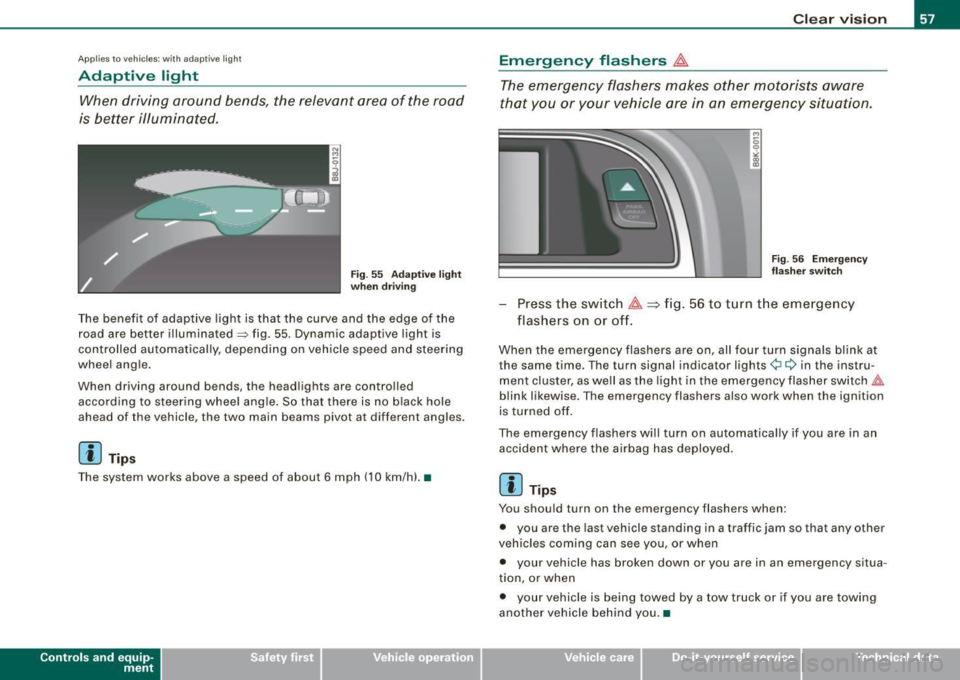
Applies to veh icles : w ith ad aptive light
Adaptive light
When driving around bends, the relevant area of the road
is better illuminated.
Fig. 55 Adaptive light
when driving
The benefit of adaptive light is that the curve and the edge of the
road are better illuminated~ fig. 55 . Dyna mic adaptive light is
controlled automatically, depending on vehicle speed and steering
wheel angle.
When driving around bends, the head lights are controlled
according to steering wheel angle . So that there is no black hole
ahead of the vehicle, the two main beams pivot at different angles.
[ i ] Tips
Th e system works above a speed of about 6 mph (10 km/hl. •
Contro ls and eq uip
ment
Clear vision
Emergency flashers
&.
The emergency flashers makes other motorists aware
that you or your vehicle are in an emergency situation.
Fig. 56 Emergency
flasher switch
Press the switch ~=>fig. 56 to turn the emergency
flashers on or off.
When the emergency flashers are on, all four turn signals blink at
the same time. The turn signal indicator lights¢¢ in the instru
ment cluster, as well as the light in the emergency flasher switch
fftt.
blink likewise. The emergency flashers also work when the ignition
is turned off.
The emergency flashers will tu rn on automatically if you are in an
accident where the airbag has deployed .
[ i ] Tips
You should turn on the emergency flashers when :
• you are the last vehicle standing in a traffic jam so that any other
vehicles coming can see you, or when
• your vehicle has broken down or you are in an emergency situa
t io n, or when
• your vehicle is being towed by a tow truck or if you are towing
another vehicle behind you.•
Vehicle care I I irechnical data
Page 71 of 360
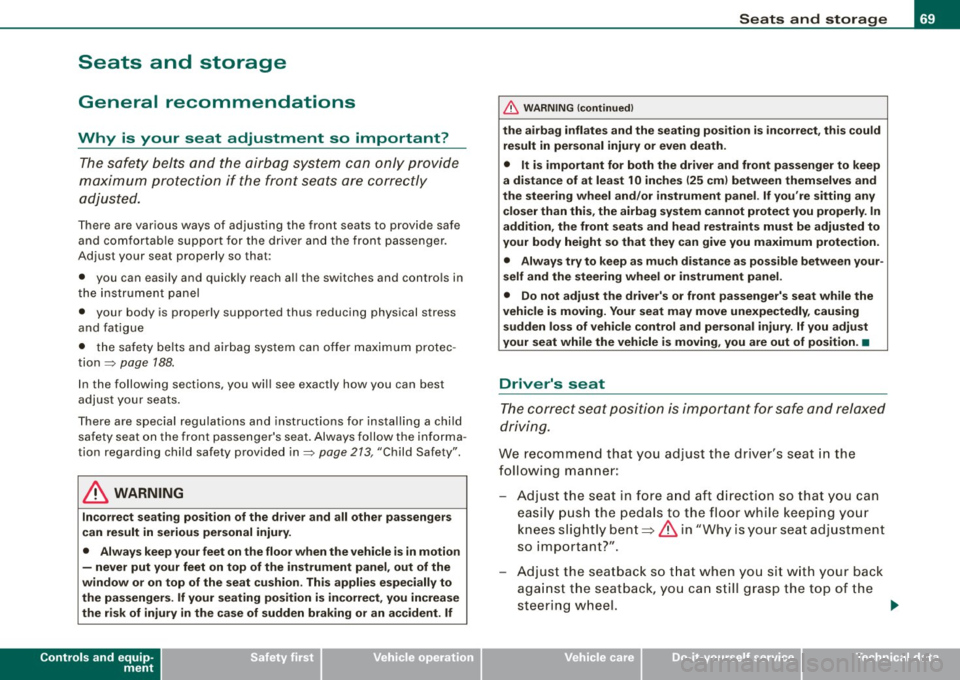
Seats and storage
General recommendations
Why is your seat adjustment so important? The safety belts and the airbag system can only provide
maximum protection if the front seats are correctly
adjusted.
The re are various ways of adjusting the front seats to provide safe
and comfortable support for the driver and the front passenger.
Adjust your seat properly so that:
• you can easily and quickly reach all the switches and controls in
the instrument panel
• your body is properly supported thus reducing physical stress
and fatigue
• the safety belts and airbag system can offer maximum protec
tion
~ page 188.
In the follow ing sections, you will see exactly how you can best
adjust your seats.
There are special regulations and instructions for installing a child safety seat on the front passenger's seat. Always follow the informa
tion regarding child safety provided in~
page 213, "C hild Safety".
& WARNING
Incorrect seating position of the driver and all other passengers
can result in serious personal injury.
• Always keep your feet on the floor when the vehicle is in motion
- never put your feet on top of the instrument panel, out of the
window or on top of the seat cushion. This applies especially to
the passengers. If your seating position is incorrect, you increase
the risk of injury in the case of sudden braking or an accident. If
Controls and equip
ment
Seats and storage
& WARNING (continued)
the airbag inflates and the seating position is incorrect, this could
result in personal injury or even death.
• It is important for both the driver and front passenger to keep
a distance of at least 10 inches (25 cml between themselves and
the steering wheel and/or instrument panel. If you're sitting any closer than this, the airbag system cannot protect you properly. In
addition, the front seats and head restraints must be adjusted to
your body height so that they can give you maximum protection.
• Always try to keep as much distance as possible between your
self and the steering wheel or instrument panel.
• Do not adjust the driver's or front passenger's seat while the
vehicle is moving. Your seat may move unexpectedly, causing
sudden loss of vehicle control and personal injury . If you adjust
your seat while the vehicle is moving, you are out of position. •
Driver's seat
The correct seat position is important for safe and relaxed
driving.
We recommend that you adjust the driver's seat in the
following manner:
Adjust the seat in fore and aft direction so that you can
easily push the pedals to the floor while keeping your
knees slightly bent=>
& in "Why is your seat adjustment
so important?".
- Adjust the seatback so that when you sit with your back
against the seatback, you can still grasp the top of the
steering wheel. ..,
I • •
Page 75 of 360
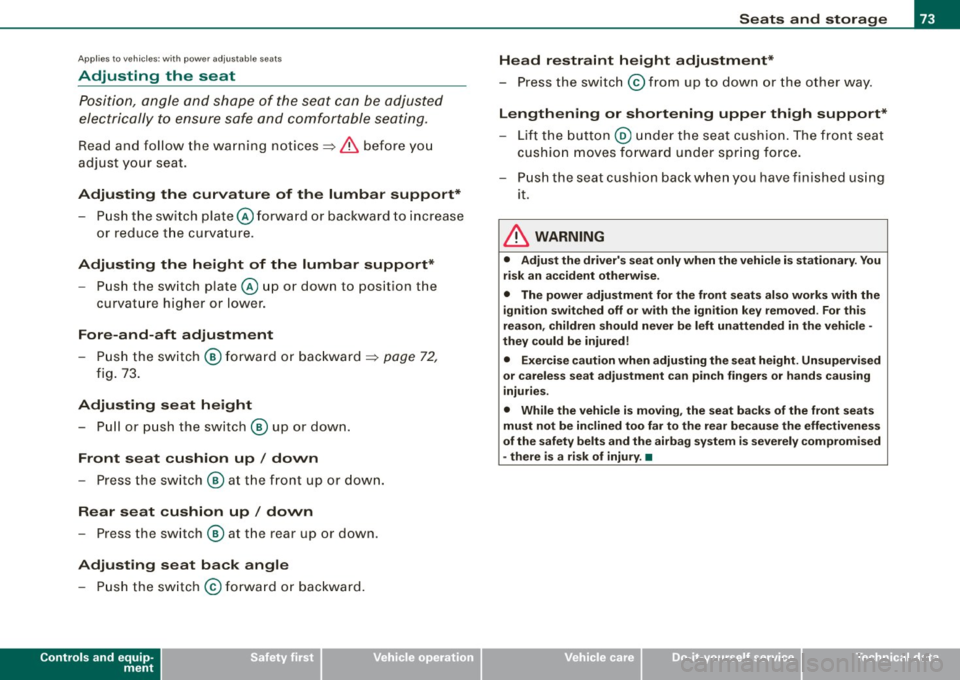
Applies to vehicles: w it h p ow er adju stable seats
Adjusting the seat
Position, angle and shape of the seat can be adjusted
electrically to ensure safe and comfortable seating.
Read and follow the warning notices~ & before you
adjust your seat.
Adjusting the curvature of the lumbar support* - Push the switch plate@forward or backward to increase
or reduce the curvature.
Adjusting the height of the lumbar support*
- Push the switch plate@ up or down to position the
curvature higher or lower.
Fore-and-aft adjustment
-Push the switch @ forward or backward ~ page 72,
fig. 73.
Adjusting seat height - Pull or push the switch @ up or down.
Front seat cushion up/ down
- Press the switch@ at the front up or down.
Rear seat cushion up / down
- Press the switch @ at the rear up or down.
Adjusting seat back angle - Push the switch @ forward or backward.
Controls and equip
ment
Seats and storage
Head restraint height adjustment*
- Press the switch @ from up to down or the other way .
Lengthening or shortening upper thigh support*
- Lift the button@ under the seat cushion. The front seat
cushion moves forward under spring force.
- Push the seat cush ion back when you have fin ished using
it.
& WARNING
• Adjust the driver's seat only when the vehicle is stationary. You
risk an accident otherwise.
• The power adjustment for the front seats also works with the
ignition switched off or with the ignition key removed . For this
reason, children should never be left unattended in the vehicle -
they could be injured!
• Exercise caution when adjusting the seat height. Unsupervised
or careless seat adjustment can pinch fingers or hands causing
injuries.
• While the vehicle is moving, the seat backs of the front seats
must not be inclined too far to the rear because the effectiveness
of the safety belts and the airbag system is severely compromised
- there is a risk of injury. •
I • •
Page 90 of 360
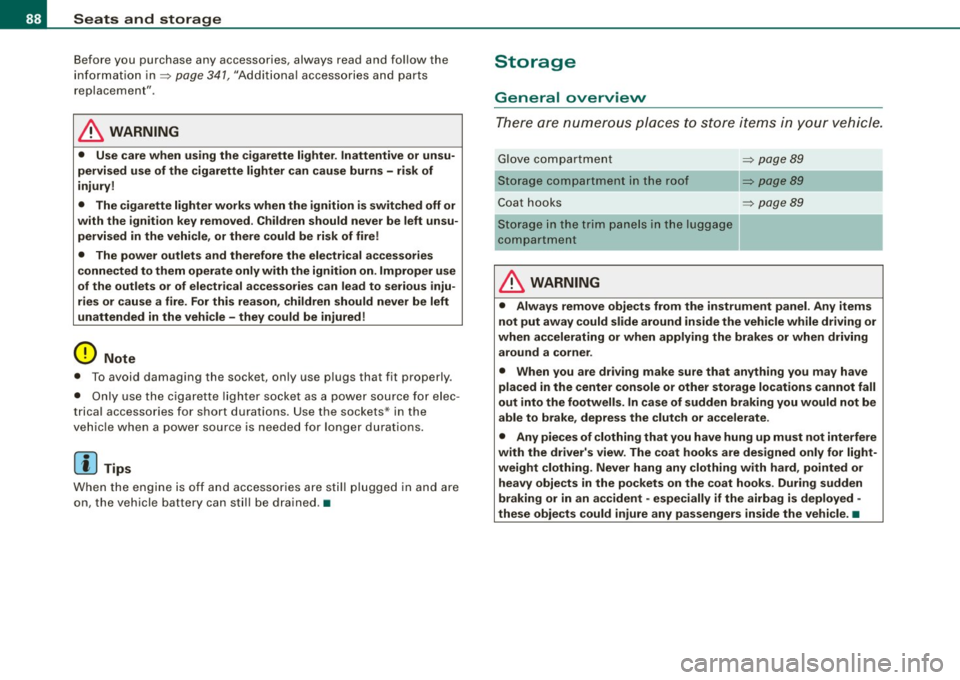
Seats and storage
Before you purchase any accessories, always read and follow the
information in=> page 341, "Additional accessories and parts
replacement".
& WARNING
• Use care when using the cigarette lighter. Inattentive or unsu
pervised use of the cigarette lighter can cause burns -risk of
injury!
• The cigarette lighter works when the ignition is switched off or
with the ignition key removed . Children should never be left unsu
pervised in the vehicle, or there could be risk of fire!
• The power outlets and therefore the electrical accessories
connected to them operate only with the ignition on. Improper use
of the outlets or of electrical accessories can lead to serious inju
ries or cause a fire. For this reason, children should never be left
unattended in the vehicle -they could be injured!
0 Note
• To avoid damaging the socket, only use plugs that fit properly .
• Only use the cigarette lighter socket as a power source for elec
trical accessories for short durations . Use the sockets* in the
vehicle when a power source is needed for longer durations.
[ i] Tips
When the engine is off and accessories are still plugged in and are
on, the vehicle battery can still be drained .•
Storage
General overview
There are numerous places to store items in your vehicle.
Glove compartment => page 89
Storage compartment in the roof =>
page 89
Coat hooks => page 89
- -Storage in the trim panels in the luggage
compartment
& WARNING
• Always remove objects from the instrument panel. Any items
not put away could slide around inside the vehicle while driving or
when accelerating or when applying the brakes or when driving around a corner .
• When you are driving make sure that anything you may have
placed in the center console or other storage locations cannot fall
out into the footwells. In case of sudden braking you would not be
able to brake, depress the clutch or accelerate.
• Any pieces of clothing that you have hung up must not interfere
with the driver's view. The coat hooks are designed only for light
weight clothing. Never hang any clothing with hard, pointed or
heavy objects in the pockets on the coat hooks . During sudden
braking or in an accident - especially if the airbag is deployed -
these objects could injure any passengers inside the vehicle . •
Page 109 of 360

----------------------------------------------~O~n~t:!..h~ e:...!.:ro~a~d!._ _J-
On the road
Steering
Manually adjustable steering wheel
The height and reach of the steering wheel can be
adjusted.
First, adj ust t he drive r's seat correct ly.
F ig . 116 L ev er unde r
th e steeri ng col umn
- Pull the lever~ fig . 11 6 -A rrow- ~ /n..
- Move the steering wheel to the desired position.
Push the lever against the steering column until it locks.
T here must be at l east 10 inches (25 cm) between your chest and the
center of the steering wheel. If you cannot sit more than 10 inches
(25 cm) from the steering wheel, see if adaptive equipment is avail
able to help you reach the pedals and increase the distance from the
steering wheel.
F or detailed information on how to ad just the driver's seat, see
=> page 72.
Con tro ls and eq uip
ment
The steering wheel can be adjusted even when the ignition is turned
off. For vehicles with seat memory, the individual positions for the
steering whee l can be stored along with the seat position.
& WARNING
Improper u se of ste ering wheel adju stme nt and improper se ating
po sition can cau se seriou s per sonal injury .
• Adju st the steering wheel column onl y when the vehi cle is not
moving to preven t los s of vehicl e control.
• Adjust the dr iver' s se at or steering wheel so that there is a
minimum of 10 inch es (25 cm ) b etwe en your che st and the
s tee ring wheel
=> pag e 170 , fig. 1 8 0. If you cannot maintain th is
minimum di stance, the airbag sy ste m cannot protect you prop
erly .
• If physical limitation s prevent you from sitting 1 O inche s (25
c m ) or mo re from the steering whee l, check with your authori zed
Audi dealer t o see if adaptive equipment i s available .
• If the stee ring whe el i s a ligned with you r fa ce, the supple
men tal driver' s airbag cannot provide as much prot ect ion in an
a c cident . A lw ays m ake sure that the steering wheel i s aligned with
your chest .
• Alway s hold t he steer ing wheel with yo ur h and s at the 9 o'c lock
a nd 3 o'clock po sition s to reduce the ri sk of per son al injury if the
dri ver' s airb ag dep lo ys .
• Neve r hold the steering wheel at the 12 o'clock po siti on or with
your hand s insid e the steeri ng wheel rim or on the steer ing wheel
hub. H olding the steerin g wheel th e wrong way can cause seri ous
i nj urie s to the h ands , arm s and head if the dr iver' s a irbag
deploy s.•
Vehicle care
I I irechnical data
Page 174 of 360

-Driving
Safely ------=-------=----------------
& WARNING
(continued)
• Passengers must always sit in an upright position and never
lean against or place any part of their body too close to the area
where the airbags are located.
• Passengers who are unbelted, out of position or too close to the
airbag can be seriously injured by an airbag as it unfolds with
great force in the blink of an eye .
• Always make sure that there are at least 10 inches (25 cm)
between the front passenger's breastbone and the instrument
panel.
• Each passenger must always sit on a seat of their own and
properly fasten and wear the safety belt belonging to that seat.
• Before driving, always adjust the front passenger seat and
head restraint properly.
• Always keep your feet on the floor in front of the seat . Never
rest them on the seat, instrument panel, out of the window, etc.
The airbag system and safety belt will not be able to protect you properly and can even increase the risk of injury in a crash.
• Never drive with the backrest reclined or tilted far back! The
farther the backrests are tilted back, the greater the risk of injury due to incorrect positioning of the safety belt and improper
seating position.
• Children must always ride in child safety seats~
page 213.
Special precautions apply when installing a child safety seat on
the front passenger seat
~ page 188 . •
Proper seating positions for passengers in
rear seats
Rear seat passengers must sit upright with both feet on
the floor consistent with their physical size and be prop
erly restrained whenever the vehicle is in use.
To reduce the risk of injury caused by an incorrect seating
position in the event of a sudden braking maneuver or an
accident, your passengers on the rear bench seat must
always observe the following:
- Make sure that the seatback is securely latched in the
upright position~
page 80.
Keep both feet flat in the footwell in front of the rear seat.
Fasten and wear safety belts properly ~
page 183.
-Make sure that children are always properly restrained in
a child restraint that is appropriate for their size and age
~ page 213.
& WARNING
Passengers who are improperly seated on the rear seat can be
seriously injured in a crash.
• Each passenger must always sit on a seat of their own and
properly fasten and wear the safety belt belonging to that seat.
• Safety belts only offer maximum protection when the seatback
is securely latched in the upright position and the safety belts are
properly positioned on the body . By not sitting upright, a rear seat
passenger increases the risk of personal injury from improperly
positioned safety belts!
• Always adjust the head restraint properly so that it can give
maximum protection . •
Page 175 of 360

Driving Safely ---------------=------------'-
Proper adjustment of head restraints
Correctly adjusted head restraints are an important part
of your vehicle's occupant restraint system and can help
to reduce the risk of injuries in accident situations.
Fig. 182 Correctly
adjusted head restraint
viewed from the side
The head restraints must be correctly adjusted to achieve
the best protection.
-Adjust the head restraint so that the upper edge of the
restraint is level with the top of your head, but no lower
than eye level and so it is as close to the back of your
head as possible ~
page 173, fig. 182.
Adjusting head restraints=> page 76.
& WARNING
Driving without head restraints or with improperly adjusted head
restraints increases the risk of serious injuries in a collision . To
help reduce the risk of injury :
• Always drive with the head restraints in place and properly
adjusted.
• Every person in the vehicle must have a properly adjusted head
restraint.
Controls and equip ment Safety first Vehicle operation
& WARNING (continued)
•
Always make sure each person in the vehicle properly adjusts
their head restraint. Each head restraint must be adjusted
according to occupants' size so that the upper edge is as even
with the top of the person's head, but no lower than eye level and
so it is as close to the back of to the head as possible .
• Never attempt to adjust head restraint while driving. If you
have driven off and must adjust the driver headrest for any reason,
first stop the vehicle safely before attempting to adjust the head
restraint.
• Children must always be properly restrained in a child restraint
that is appropriate for their age and size=>
page 213. •
Examples of improper seating positions
The occupant restraint system can only reduce the risk of
injury if vehicle occupants ore properly seated.
Improper seating positions can cause serious injury or
death . Safety belts can only work when they are properly
positioned on the body. Improper seating positions reduce
the effectiveness of safety belts and will even increase the
risk of injury and death by moving the safety belt to critical
areas of the body. Improper seating positions also increase
the risk of serious injury and death when an airbag deploys
and strikes an occupant who is not in the proper seating
position. A driver is responsible for the safety of all vehicle
occupants and especially for children. Therefore:
- Never allow anyone to assume an incorrect seating posi
tion when the vehicle is being used~& .
The following bulletins list only some sample positions that will
increase the risk of serious injury and death. Our hope is that these .,_
Vehicle care Do-it-yourself service Technical data